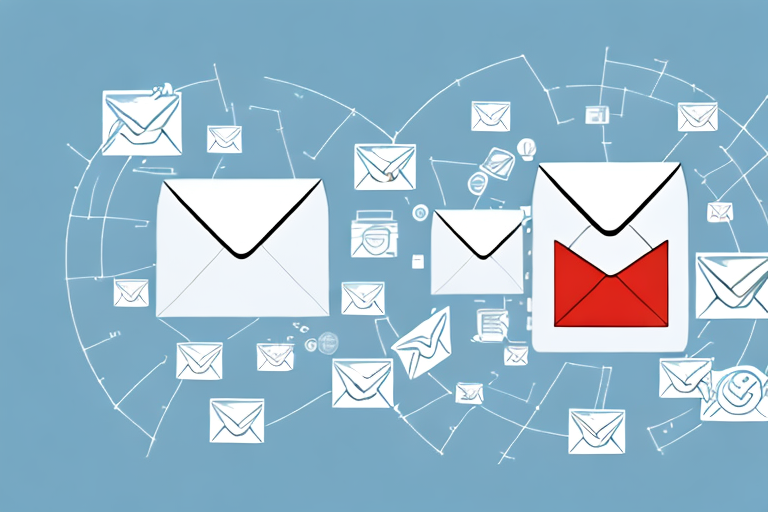The Importance of Email Marketing in Modern Marketing Strategies
Discover how email marketing has become a game-changer in modern marketing strategies.

Email marketing has become an indispensable tool for businesses in today's digital age. With the constant evolution of marketing strategies, businesses need to stay ahead of the game to remain competitive. In this article, we will explore the various aspects of email marketing and why it plays a vital role in modern marketing strategies. From understanding the fundamentals of email marketing to measuring its success and discussing future trends, we will cover it all.
Understanding Email Marketing
Defining Email Marketing
Email marketing involves sending targeted messages to a group of individuals via email. It allows businesses to reach their customers directly, build relationships, and drive conversions. Unlike traditional marketing methods, which rely on printed materials or advertisements, email marketing is cost-effective and highly measurable.
Email marketing has revolutionized the way businesses communicate with their customers. It has become an essential tool in the digital marketing landscape, enabling companies to connect with their audience on a personal level. By leveraging the power of email, businesses can deliver tailored content and offers directly to their subscribers' inboxes, ensuring that their message gets seen.
The Evolution of Email Marketing
Email marketing has come a long way from its humble beginnings. It started as simple text-based newsletters, where businesses would send plain emails with basic information. However, as technology advanced, so did email marketing.
Today, email marketing has transformed into a dynamic and interactive medium. Marketers can now create visually appealing and engaging email campaigns that captivate the recipient's attention. With the introduction of HTML emails, businesses can incorporate images, videos, and interactive features into their messages, making them more engaging and memorable.
Furthermore, the evolution of email marketing has been fueled by the availability of advanced tools and technologies. Email service providers now offer robust platforms that allow marketers to design, automate, and analyze their email campaigns with ease. These tools provide features like drag-and-drop editors, A/B testing, segmentation, and detailed analytics, empowering businesses to optimize their email marketing efforts and achieve better results.
Another significant development in email marketing is the rise of mobile devices. With the increasing use of smartphones and tablets, emails are now being accessed on a variety of screens and platforms. Marketers must ensure that their email campaigns are mobile-friendly and responsive, adapting to different screen sizes and providing an optimal user experience.
In conclusion, email marketing has evolved into a powerful marketing channel that enables businesses to connect with their audience effectively. From its simple beginnings as text-based newsletters to the current era of visually stunning and interactive emails, email marketing continues to evolve and adapt to the ever-changing digital landscape.
The Role of Email Marketing in Modern Business
Building Customer Relationships
Email marketing enables businesses to establish and nurture long-lasting relationships with their customers. By sending personalized and relevant content, businesses can earn the trust and loyalty of their subscribers. Regular communication through email helps businesses stay top-of-mind and ensures that customers feel valued and engaged.
For example, imagine a small online clothing boutique that uses email marketing to connect with its customers. In addition to sending out newsletters featuring new arrivals and exclusive discounts, the boutique also includes personalized recommendations based on each customer's previous purchases. This level of personalization not only shows that the boutique values its customers but also helps to create a sense of anticipation and excitement for future emails.
Enhancing Brand Awareness
An effective email marketing strategy can significantly enhance a brand's visibility and awareness. Through consistent branding, compelling messaging, and creative design, businesses can reinforce their brand identity in the minds of their subscribers. By showcasing their products, sharing success stories, and offering exclusive promotions, businesses can generate interest and drive traffic to their website.
For instance, let's consider a startup company that specializes in eco-friendly home products. Through their email marketing campaigns, they not only highlight their products but also educate their subscribers about the importance of sustainable living. They share success stories of customers who have made positive changes in their homes and provide tips and tricks for incorporating eco-friendly practices. By doing so, this company not only promotes its brand but also positions itself as a thought leader in the industry.
Furthermore, email marketing allows businesses to segment their audience and tailor their messages accordingly. By understanding their subscribers' preferences and interests, businesses can send targeted emails that resonate with their audience. This level of personalization not only increases the chances of engagement but also helps to build a stronger brand connection.
In conclusion, email marketing plays a crucial role in modern business by building customer relationships and enhancing brand awareness. Through personalized content and strategic messaging, businesses can foster loyalty and trust, while also increasing their visibility and driving traffic to their website. By leveraging the power of email marketing, businesses can stay ahead in the competitive digital landscape and achieve long-term success.
Key Components of Effective Email Marketing
Crafting Compelling Content
The success of an email campaign largely depends on the quality of the content. Emails should be concise, engaging, and tailored to the subscribers' interests. By utilizing storytelling techniques, including captivating subject lines, and providing valuable information or offers, businesses can encourage recipients to open, read, and act on their emails.
When crafting compelling content, it is important to consider the tone and language used in the email. The tone should match the brand's personality and resonate with the target audience. Whether it's a friendly and conversational tone or a professional and informative one, the content should be written in a way that connects with the readers and makes them feel valued.
Furthermore, the use of visuals can greatly enhance the effectiveness of email marketing. Including eye-catching images, videos, or infographics can capture the attention of subscribers and make the content more engaging. Visuals can also help convey information more effectively and leave a lasting impression on the recipients.
Segmenting Your Audience
Segmentation is a crucial aspect of email marketing. By dividing subscribers into distinct groups based on demographics, behavior, or preferences, businesses can deliver highly targeted messages. Sending relevant content to specific segments not only increases the likelihood of conversions but also enhances customer satisfaction and reduces unsubscribes.
When segmenting the audience, businesses can consider various factors such as age, gender, location, purchase history, or engagement level. This allows them to create personalized email campaigns that address the specific needs and interests of each segment. For example, a clothing retailer can send different emails to male and female subscribers, showcasing products that are more likely to appeal to each gender.
Segmentation also enables businesses to send automated emails triggered by specific actions or events. For instance, a customer who abandons their shopping cart can receive a follow-up email with a special discount to encourage them to complete the purchase. By leveraging segmentation, businesses can maximize the relevance and impact of their email marketing efforts.
Measuring the Success of Email Marketing
Key Performance Indicators (KPIs)
Measuring the success of email campaigns is essential to understand their effectiveness and make data-driven decisions. Key Performance Indicators (KPIs) such as open rates, click-through rates, conversion rates, and unsubscribe rates provide valuable insights into the performance of an email campaign. Businesses can use these metrics to optimize their strategies, improve engagement, and ultimately achieve their marketing goals.
Open rates indicate the percentage of recipients who open an email, giving businesses an idea of how well their subject lines and pre-header text are capturing attention. A high open rate suggests that the email content is relevant and compelling to the audience, while a low open rate may indicate a need for improvement in these areas.
Click-through rates measure the percentage of recipients who click on links within an email. This metric helps businesses gauge the effectiveness of their call-to-action (CTA) buttons and the overall layout and design of their emails. A high click-through rate indicates that the email content is engaging and persuasive, while a low click-through rate may signal a need for more enticing CTAs or a redesign of the email template.
Conversion rates track the percentage of recipients who take a desired action, such as making a purchase or filling out a form, after clicking on a link in an email. This metric is crucial for measuring the effectiveness of email campaigns in driving actual business outcomes. A high conversion rate indicates that the email content and the landing page it leads to are persuasive and user-friendly, while a low conversion rate may suggest the need for optimization in these areas.
Unsubscribe rates indicate the percentage of recipients who choose to unsubscribe from future emails. While it is natural for some recipients to opt-out, a high unsubscribe rate may indicate issues with email frequency, relevance, or overall content quality. By monitoring and analyzing unsubscribe rates, businesses can identify potential problems and take steps to address them, such as adjusting their email frequency or segmenting their audience more effectively.
Analyzing Email Marketing Data
Data analysis plays a pivotal role in email marketing success. By tracking and analyzing email marketing data, businesses can identify trends, pinpoint areas for improvement, and make informed decisions. Understanding customer behaviors, preferences, and purchase patterns allows businesses to refine their email marketing strategies and deliver more personalized and impactful messages.
Through data analysis, businesses can gain insights into the best days and times to send emails, helping them optimize their email delivery schedule for maximum engagement. By examining engagement metrics across different segments of their audience, businesses can also identify specific groups that may require tailored content or offers, leading to higher conversion rates.
Moreover, data analysis can reveal valuable information about customer preferences and interests. By tracking which types of content or products generate the most engagement, businesses can fine-tune their email content to cater to these preferences and increase overall customer satisfaction. For example, if data analysis shows that recipients are more likely to engage with emails containing educational content, a business can focus on creating informative newsletters or tutorials to drive engagement and build brand loyalty.
Additionally, data analysis can help businesses identify potential issues or bottlenecks in the customer journey. By analyzing email engagement metrics in conjunction with website analytics, businesses can pinpoint areas where recipients drop off or fail to convert. This insight allows businesses to optimize their email campaigns and website experience to remove any barriers and improve the overall customer journey.
In conclusion, measuring the success of email marketing campaigns through KPIs and analyzing email marketing data are crucial steps for businesses to optimize their strategies, improve engagement, and achieve their marketing goals. By leveraging these insights, businesses can deliver more personalized and impactful messages, resulting in higher open rates, click-through rates, conversion rates, and ultimately, better business outcomes.
Future Trends in Email Marketing
Personalization and Automation
The future of email marketing lies in personalized and automated campaigns. By leveraging data and utilizing sophisticated automation tools, businesses can deliver hyper-personalized content at scale. From dynamic content based on individual preferences to triggered emails based on specific actions, personalization and automation will continue to revolutionize the effectiveness of email marketing.
Mobile-First Email Marketing
With the increase in mobile device usage, optimizing email campaigns for mobile users has become imperative. Mobile-first email marketing involves designing emails specifically for mobile screens, using responsive templates, and optimizing load times. By creating a seamless experience for mobile users, businesses can ensure higher open rates, engagement, and conversions.
In conclusion, email marketing has become an invaluable tool in modern marketing strategies. It allows businesses to connect with their customers on a personal level, build strong relationships, and drive tangible results. By understanding the fundamentals, incorporating key components, measuring success, and embracing the future trends, businesses can unlock the full potential of email marketing and stay ahead in today's competitive landscape.





